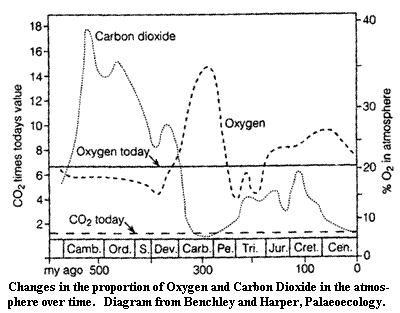| The Atmosphere | ||
| THE EARTH | Atmosphere Home |
Cosmic Evolution |
Earth: Geosphere Hydrosphere Atmosphere Oxygen in the Atmosphere Carbon Dioxide in the Atmosphere Plate tectonics Paleogeography Biogeochemical cycles Climate Gaia Hypothesis Glossary |

Oxygen and carbon dioxide have their own sections. See links provided. The other biologically important components of the atmosphere share a common feature: their geochemistry is complex and incredibly difficult to explain. At the moment, we will elect the path of prudence (or cowardice, if you must) and avoid any serious explanation. However, we will add a note about nitrogen.
Nitrogen levels have been essentially constant from very early on -- before the Proterozoic. For most organisms, however, the issue is not molecular nitrogen (N2), but the availability of nitrates (NO3-). Nitrates are essential for making fundamental compounds such as amino acids and nucleotides. Some nitrate can be obtained by oxidizing ammonia and uric acid. But these are mostly encountered as metabolic wastes, so that this comes under the heading of recycling. Nitrates are initially created by nitrogen-fixing bacteria, and that creates a problem. The enzyme responsible for nitrogen fixation, nitrogenase, is poisoned by oxygen. Thus, when oxygen started to become a significant factor during the Proterozoic, this opened up the high-energy reactions of oxidative metabolism. However, by the same token, the availability of nitrates then became a significant limiting factor. Berman-Frank et al. (2003). Nitrogen-fixing bacteria eventually found several different ways to solve the problem. The most successful and efficient of these were the heterocystic cyanobacteria (e.g. Nostoc) which are able to simultaneously carry on photosynthesis and nitrogen fixation by evolving two alternate phenotypes: a "normal" photosynthetic form and a variable population of cells that exclude oxygen and specialize in nitrogen fixation. Lindberg et al. 2004). Nostoc in particular has evolved a number of close symbiotic relationships with green plants. However, in the free state, these bacteria are generally found as filamentous green algae in fresh and brackish waters. Perhaps this accounts, in part, for the rapid evolution of animals and plants in just these environments during the Neoproterozoic and Cambrian.
Berman-Frank, I, P Lundgren & P Falkowski (2003), Nitrogen fixation and photosynthetic oxygen evolution in cyanobacteria. Res. Microbiol. 154: 157-164.
Lindberg, P, P Lindblad & L Cournac (2004), Gas exchange in the filamentous cyanobacterium Nostoc punctiforme Strain ATCC 29133 and its hydrogenase-deficient mutant Strain NHM5. Appl. Environ. Microbiol.70: 2137-2145.
Encyclopedia of the Atmospheric Environment
Developed by the Atmospheric Research and Information Centre, the Encyclopedia contains a wealth of information in over 400 topics on atmospheric issues including:
Acid Rain;
Air Quality;
Atmosphere;
Climate;
Climate Change;
Global Warming;
Ozone Depletion;
Sustainability;
Weather.
Each page of information has numerous links to other relevant web pages, websites and on-line organizations.